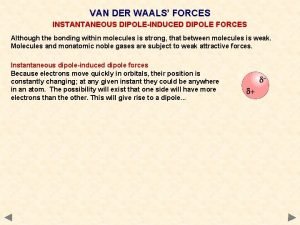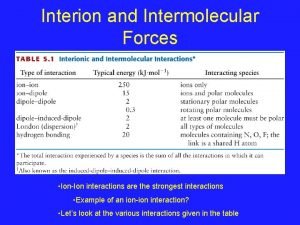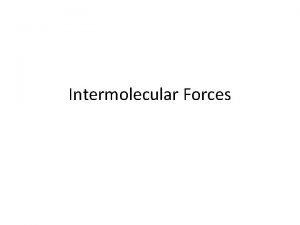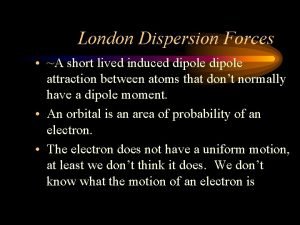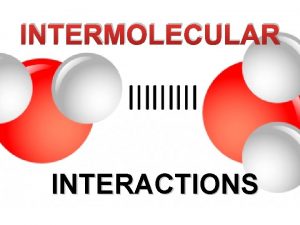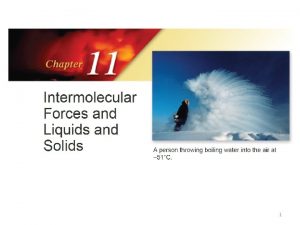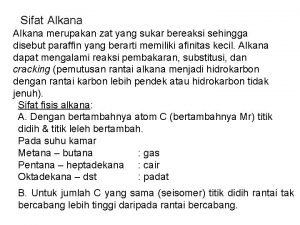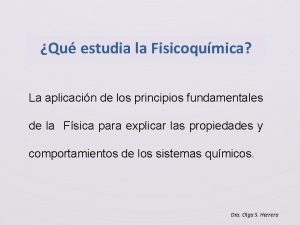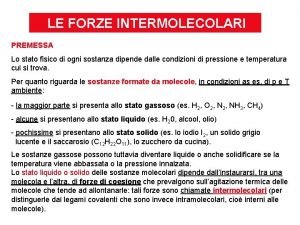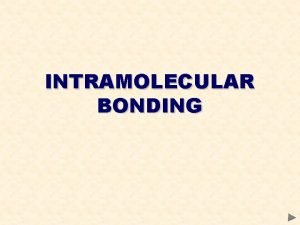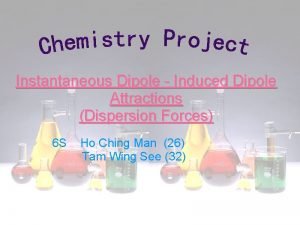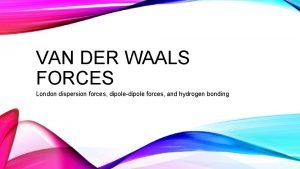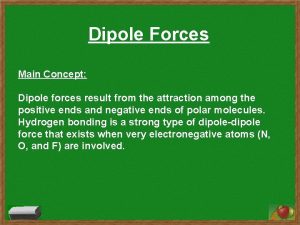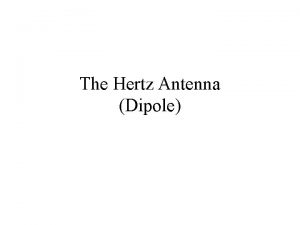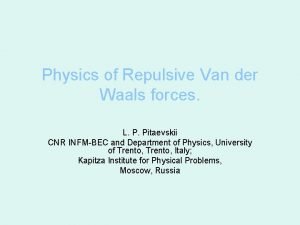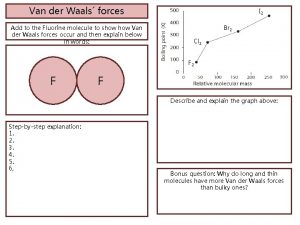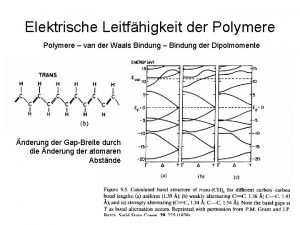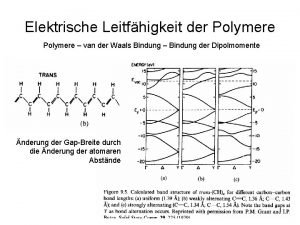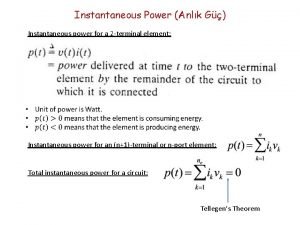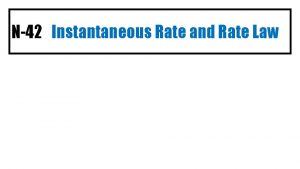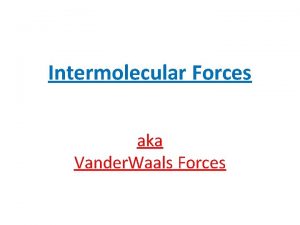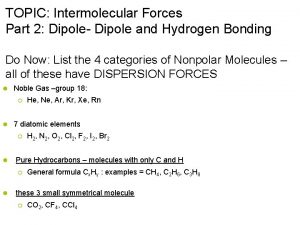VAN DER WAALS FORCES INSTANTANEOUS DIPOLEINDUCED DIPOLE FORCES















- Slides: 15

VAN DER WAALS’ FORCES INSTANTANEOUS DIPOLE-INDUCED DIPOLE FORCES Although the bonding within molecules is strong, that between molecules is weak. Molecules and monatomic noble gases are subject to weak attractive forces. Instantaneous dipole-induced dipole forces Because electrons move quickly in orbitals, their position is constantly changing; at any given instant they could be anywhere in an atom. The possibility will exist that one side will have more electrons than the other. This will give rise to a dipole. . .

VAN DER WAALS’ FORCES INSTANTANEOUS DIPOLE-INDUCED DIPOLE FORCES Although the bonding within molecules is strong, that between molecules is weak. Molecules and monatomic noble gases are subject to weak attractive forces. Instantaneous dipole-induced dipole forces Because electrons move quickly in orbitals, their position is constantly changing; at any given instant they could be anywhere in an atom. The possibility will exist that one side will have more electrons than the other. This will give rise to a dipole. . . The dipole on one atom induces dipoles on nearby atoms Atoms are now attracted to each other by a weak forces The greater the number of electrons, the stronger the attraction and the greater the energy needed to separate the particles.

VAN DER WAALS’ FORCES INSTANTANEOUS DIPOLE-INDUCED DIPOLE FORCES Although the bonding within molecules is strong, between molecules it is weak. Molecules and monatomic gases are subject to weak attractive forces. Instantaneous dipole-induced dipole forces Electrons move quickly in orbitals, so their position is constantly changing; at any given time they could be Anywhere in an atom. The possibility exists that one side has More electrons than the other. This will give rise to a dipole. . . The dipole on one atom induces dipoles on others Atoms are now attracted to each other by a weak forces The greater the number of electrons, the stronger the attraction and the greater the energy needed to separate the particles. He Ne Ar Kr NOBLE GASES Electrons B pt. 2 -269°C 10 -246°C 18 -186°C 36 -152°C CH 4 C 2 H 6 C 3 H 8 ALKANES Electrons 10 18 26 B pt. -161°C - 88°C - 42°C

ELECTRONEGATIVITY ‘The ability of an atom to attract the electron pair in a covalent bond to itself’ Non-polar bond similar atoms have the same electronegativity they will both pull on the electrons to the same extent the electrons will be equally shared Polar bond different atoms have different electronegativities one will pull the electron pair closer to its end it will be slightly more negative than average, dthe other will be slightly less negative, or more positive, d+ a dipole is formed and the bond is said to be polar greater electronegativity difference = greater polarity Pauling Scale a scale for measuring electronegativity

ELECTRONEGATIVITY Pauling Scale a scale for measuring electronegativity values increase across periods values decrease down groups fluorine has the highest value INCREASE ‘The ability of an atom to attract the electron pair in a covalent bond to itself’ INCREASE H 2. 1 Li Be B C N O F 1. 0 1. 5 2. 0 2. 5 3. 0 3. 5 4. 0 Na Mg Al Si P S 0. 9 1. 2 1. 5 1. 8 2. 1 2. 5 Cl 3. 0 K Br 0. 8 2. 8

DIPOLE-DIPOLE INTERACTION Occurrence occurs between molecules containing polar bonds acts in addition to the basic van der Waals’ forces the extra attraction between dipoles means that more energy must be put in to separate molecules get higher boiling points than expected for a given mass Boiling points of hydrides CH 4 Si. H 4 Ge. H 4 Sn. H 4 Mr 16 32 77 123 °C -161 -117 -90 -50 NH 3 PH 3 As. H 3 Sb. H 3 17 34 78 125 -33 -90 -55 -17 H 2 O H 2 Se H 2 Te Mr 18 34 81 130 °C +100 -61 -40 -2 HF HCl HBr HI 20 36. 5 81 128 +20 -85 -69 -35

POLAR MOLECULES Occurrence not all molecules containing polar bonds are polar overall if bond dipoles ‘cancel each other’ the molecule isn’t polar if there is a ‘net dipole’ the molecule will be polar HYDROGEN CHLORIDE NET DIPOLE - POLAR TETRACHLOROMETHANE NON-POLAR WATER NET DIPOLE - POLAR

POLAR MOLECULES Evidence place a liquid in a burette allow it to run out place a charged rod alongside the stream of liquid polar molecules are attracted by electrostatic attraction non-polar molecules will be unaffected NET DIPOLE - POLAR NON-POLAR

BOILING POINTS OF HYDRIDES GROUP IV CH 4 Si. H 4 Ge. H 4 Sn. H 4 Mr 16 32 77 123 °C -161 -117 -90 -50 GROUP V NH 3 PH 3 As. H 3 Sb. H 3 17 34 78 125 -33 -90 -55 -17 GROUP VI H 2 O H 2 S H 2 Se H 2 Te Mr 18 34 81 130 °C +100 -61 -40 -2 GROUP VII HF HCl HBr HI 20 36. 5 81 128 +20 -85 -69 -35 The values of certain hydrides are not typical of the trend you would expect

BOILING POINTS OF HYDRIDES 100 BOILING POINT / C° GROUP IV The boiling points of the hydrides increase with molecular mass. CH 4 has the lowest boiling point as it is the smallest molecule. 0 100 50 140 Pb. H 4 Ge. H 4 Si. H 4 -160 CH 4 Larger molecules have greater intermolecular forces and therefore higher boiling points Mr

BOILING POINTS OF HYDRIDES 100 BOILING POINT / C° GROUP V NH 3 has a higher boiling point than expected for its molecular mass. There must be an additional intermolecular force. 0 -160 50 NH 3 100 140 Mr

BOILING POINTS OF HYDRIDES 100 H 2 O BOILING POINT / C° GROUP VI H 2 O has a very much higher boiling point for its molecular mass. There must be an additional intermolecular force. 0 -160 50 100 140 Mr

BOILING POINTS OF HYDRIDES 100 BOILING POINT / C° GROUP VII HF has a higher boiling point than expected for its molecular mass. There must be an additional intermolecular force. HF 0 -160 50 100 140 Mr

BOILING POINTS OF HYDRIDES BOILING POINT / C° 100 H 2 O The higher than expected boiling points of NH 3, H 2 O and HF are due to intermolecular HYDROGEN BONDING HF 0 50 100 140 Mr NH 3 GROUP IV GROUP VII -160

BOILING POINTS OF HYDRIDES BOILING POINT / C° 100 0 50 100 140 Mr GROUP IV GROUP VII -160
 Van der waals attraction
Van der waals attraction Dipole dipole vs ion dipole
Dipole dipole vs ion dipole Hybrid bonding
Hybrid bonding Intermolecular forces
Intermolecular forces London dispersion force
London dispersion force Dispersion forces vs dipole dipole
Dispersion forces vs dipole dipole Chem ufl
Chem ufl Dispersion forces vs dipole dipole
Dispersion forces vs dipole dipole Dipole induced dipole forces examples
Dipole induced dipole forces examples Trigonal bipiramida
Trigonal bipiramida Atom tersier
Atom tersier Ecuacion de estado de van der waals
Ecuacion de estado de van der waals No polar
No polar Ligação de van der waals
Ligação de van der waals Gaya van der waals adalah
Gaya van der waals adalah Stato liquido
Stato liquido
